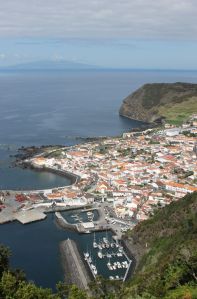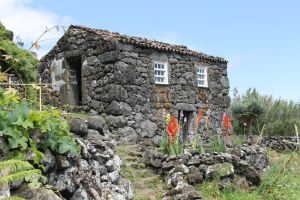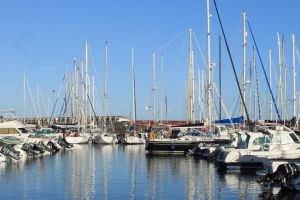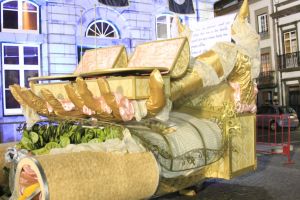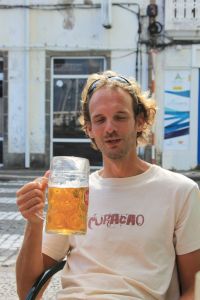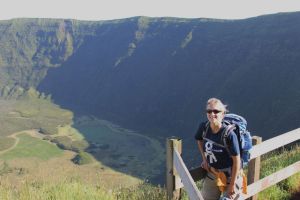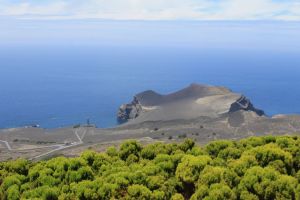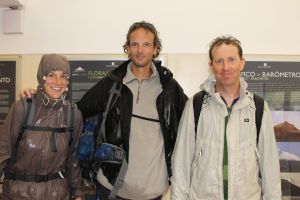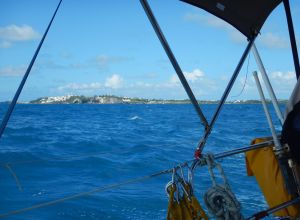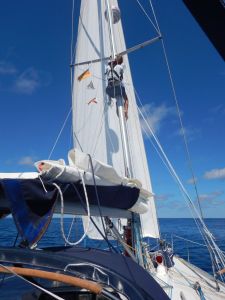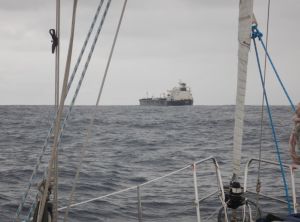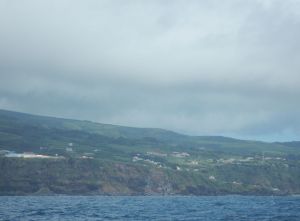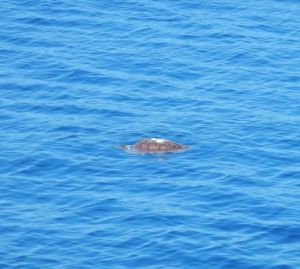Since our arrival in Flores more than a week ago, we have enjoyed mainly three things: natural beauty, extremely friendly locals, and an amazing community spirit among sailors.
As for the natural beauty and the friendly locals, Flores is a true gem! You feel it directly when you enter the harbour. It is nothing more than a tiny basin for around 50 boats which is located off massive cliffs on the south west coast of the island. The harbour is protected by big breakwaters towards the South and the West (the cliffs giving natural shelter in the North) and open to the east and northeast.
When we arrived, the harbour was quite full, and there was a queue of people wanting to check in with the harbour master. You would think that this would cause the harbour master to be a bit grumpy about too much work, or at least be stressed. None of these things! He welcomed everyone with warm words, smiling all over the face, giving everyone a feeling of coming home; this smile lasted until he asked us how long we wanted to stay. We said “oh, we want to stay at least over the weekend to enjoy the island”. Then his face took on a serious expression and he said: “You will think about this twice in a minute…” and he showed us the weather forecast which predicted eastern winds from Monday night onwards. We knew that Flores harbour was exposed to winds and swell from the east and northeast but hadn’t been sure how bad the impact would be for boats moored in the harbour. So now we knew and had to adapt our plans: enjoying Flores as much as we could within one day and then head on to the more protected harbour of Horta on the island of Faial – 130 nm to the Southeast of Flores.
Luckily, our friends from White Witch who had already been touring around Flores for a couple of days, recommended us to hire a car to see as much as possible from this beautiful island. The first stop of our island tour didn’t lead us very far – only to the petrol station about 1.5km up the road. Our first priority was to fill our diesel tank again (this time with cleaner diesel) because we would still need to use our motor to complete the passage to Horta. The harbour of Flores being very small, you immediately start talking to your neighbours on the pontoon and it turned out that several boats were facing the challenge of getting to the petrol station and then back to the boats with full jerry cans. So our little rental car ended up carrying 17 jerry cans in its trunk (a total of about 280l) divided among four boats.
After a short stop in the local supermarket (the first fresh produce since Bermuda, only that this time prices were much more enjoyable!), we finally set off for some sightseeing. What we saw truly amazed us: rough and steep cliffs, green hills, lakes, black stone/lava beaches, crystal clear water, and thousands of flowers decorating the sides of the roads. Whenever we stopped with the car we saw boards indicating hiking paths into different directions. We could have spent a week hiking without ta problem. Due to the limited time, we only did a small hike of two hours, but it was more than enough to get an impression of the landscape of the island.
In short: Flores clearly merits its name (Flores= Flowers) and we can recommend it to anyone who likes nature and hiking!
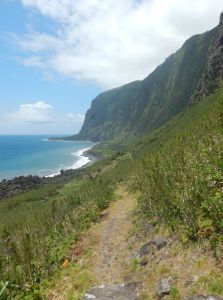
Our hiking path along the cliffs of Flores
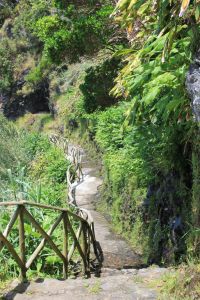

Maarten and Stephan from Batjar enjoying the view over the coastline

beautiful to see but less idyllic to anchor – we were happy to be in the harbour

The stone beach

La Lagoa Negra (Black lagoon) in the hills of Flores
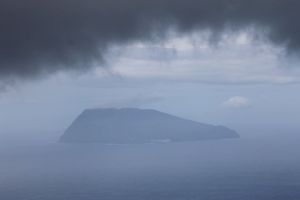
the little neighbouring Island of Corvo appears below a rain cloud

Flowers grow along most of the roads on Flores and make every drive a pleasure


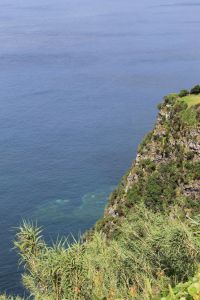
Chrystal clear water around the Island

On Sunday morning, we set off to Horta. The conditions for this trip were “ideal” for us – mostly no wind at all! We were clearly done with motoring, but at the same time, we didn’t want to take any risk with our mast. Upon departure, our plotter showed a long row of AIS signs all heading from Flores to Horta; the harbour master had done a good job kicking everyone out before the Eastern Wind would arrive 🙂
The highlight of this overnight trip was a tuna on our fishing rod! After three weeks of unsuccessful fishing, it took only 2 minutes of fishing and the tuna ended up on the hook. Compared to what fisherman pull on land here, it was small, but nonetheless provided us with a delicious dinner (grilled tuna steak) for two days!

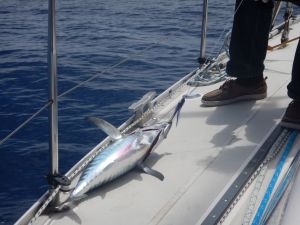
So here we are now, in Horta.
The harbour has traditionally been called the “crossroads of the Atlantic” because everyone arriving here has sailed a considerable distance: coming from the Caribbean (about 2400nm), from Bermuda (1700nm), from mainland Spain/Portugal (800-900nm), from Ireland/UK (1200nm), from Canaries (700nm). Indeed, when I looked at the boats around Ojalá, it was easy to see that many of them had made a long voyage: people where repairing things, filling up many jerry cans of diesel or just relaxing after a long time on the ocean.

Punta de Capelinhos (Faial) in the morning light upon our arrival from Flores (NW Point)

The Southern coast of Faial

Horta and the marina
During the months of May and June, it is high season for the Azores. The harbour master and border control need to do extra hours. Within the 48 hours around our arrival in the Azores, the harbour of Horta saw 60 boats going in and out. In other words, the harbour is packed. When we arrived, we were the fourth boat moored alongside a concrete wall (the harbour’s breakwater to the East) and the channel in the harbour basin was reduced to a one way street – going in either forward or backward, no turning possible. After all the anchoring we have done during the past months, it is strange to look out of the windows and see people sitting just a meter away in the neighbours cockpit. We also haven’t had people walking over our deck to get on land since our departure from Northern Europe last year. Nonetheless, we greatly enjoy it here. The atmosphere is extremely relaxed and everyone talks to everyone. In this way, a trip to the showers can turn into a 45 minute undertaking because there is always a chance to run into someone whom you have met before and with whom you end up having a short talk.
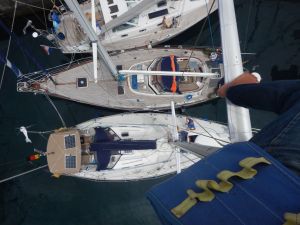
our neighbours seen from the mast
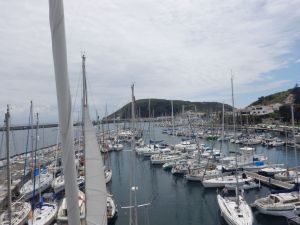
view over the full harbour
The breakwater we are moored to right now isn’t just any breakwater. In fact, it is a collection of fine sailors’ art, some of it a decade old: traditionally, boats staying in Horta have left a painting on one of the harbour walls. Apparently, it brings bad luck to leave the harbour without having done so, and it will be one of our priorities to bring our painting on the wall before we leave from here; we are currently just gathering inspiration from other boats :-).

a few meters of breakwater
So far, our days here have been dominated by substantial maintenance of our motor after all the hours it had to run (partially with the strangely brown diesel). It seemed to be just the right moment, because all the filters were black – understandable after 1050 miles of motoringL! Moreover, we have tried to get our broken shroud fixed. Initially, it seemed to be possible to repair it here but finally things turned out to be more complicated and we are now waiting for new parts to be sent in from Germany. We hope that our mast is complete again by the end of next week (around 19th of June).
Fortunately, this is truly not an environment to get bored! We spend considerable time socializing with our Dutch friends, welcoming Volonté and cheering “good bye” to our friends from Batjar who were the first ones to start the trip back to the Netherlands today. But also outside the “Dutch fleet”, it is extremely easy to get in contact with fellow sailors. Yesterday, we enjoyed a delicious dinner onboard of our English neighbour who crossed the Atlantic all by himself and was happy to share with us some information over the west coast of England. A couple of days ago, we enjoyed a beer with the crew of an Irish boat with whom we had been in contact since our departure from the Bahamas, soaking up their information about the South and East coast of Ireland like a sponge. In short, it is a great community here and we are happy and also proud to be part of it!
All the information we are gathering now will probably be extremely useful during the coming months: after cruising the Azores a little bit more until the end of the month (provided our mast is fixed), we are planning to head on to the Irish Southern coast. From there we would like to move along the Irish east coast via the Irish Sea towards the west coast of England and then Scotland. Depending on the timing and the weather, we would make our way through the Caledonian Channel or the islands along the North coast of Scotland back into the North Sea and then head back to the Netherlands.
Nonetheless, as we have learnt, long-term planning is always difficult with sailing and for now, we will focus on the more immediate future: with most of the work being done, all that is left is to wait for our shrouds to arrive. Therefore, we will be able to use the time to do some more hiking on Faial (the island Horta is located on) and also the neighbouring island of Pico which is home to a volcano with the same name and at the same time Portugal’s highest mountain. More impressions to follow in our next blog!

The Pico – if our physical condition and weather allow for it, we will give it a try and climb it next week.
